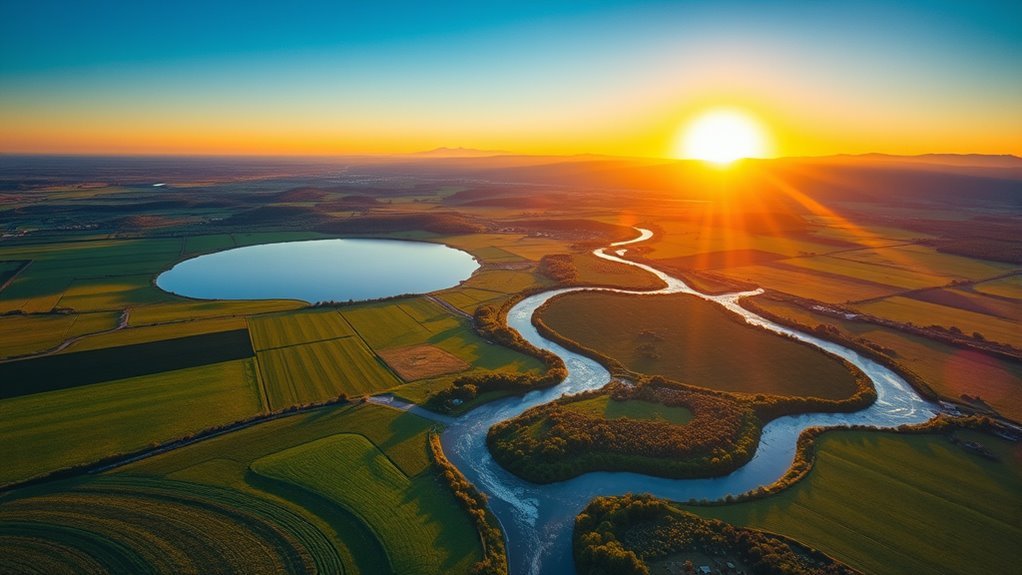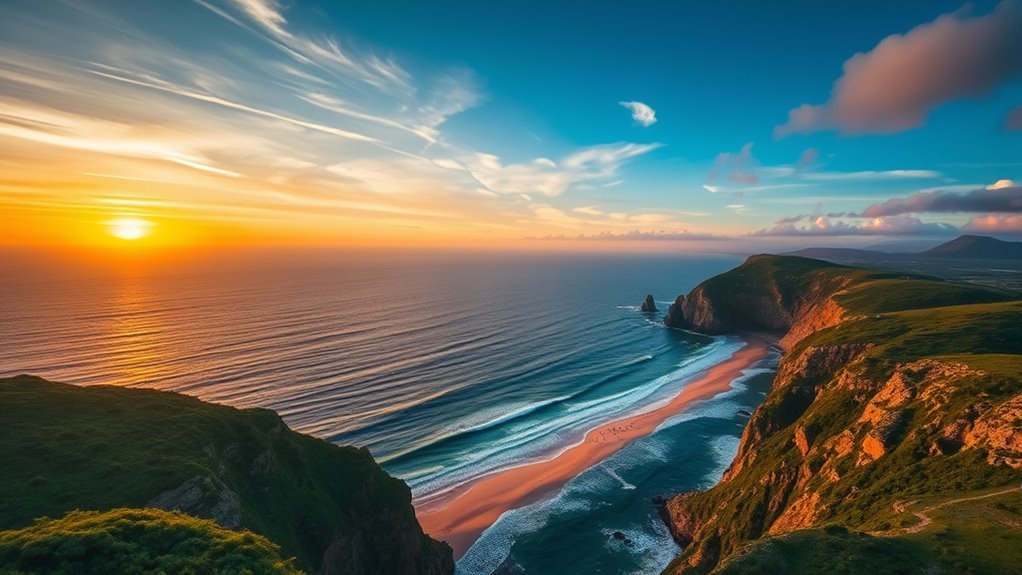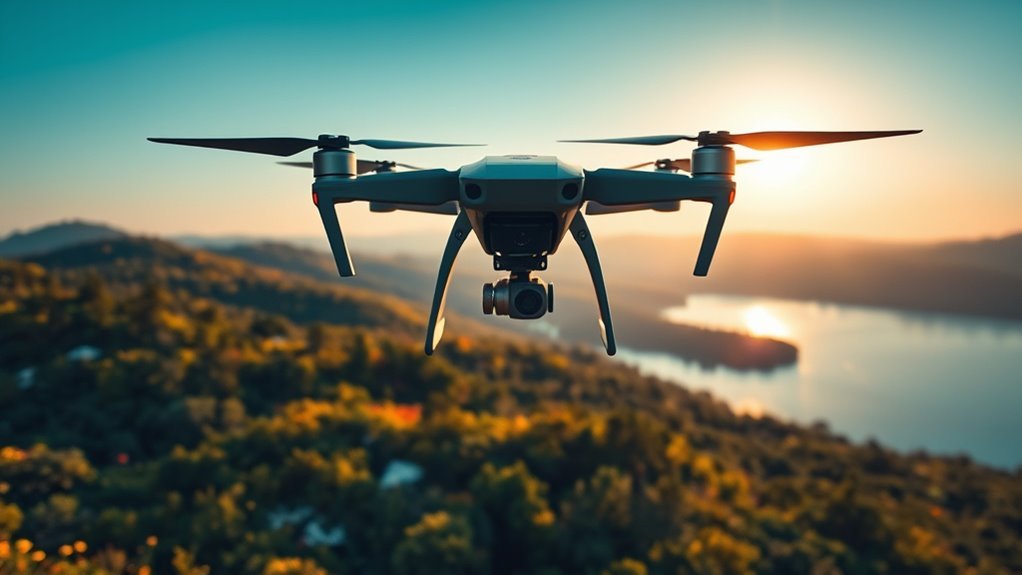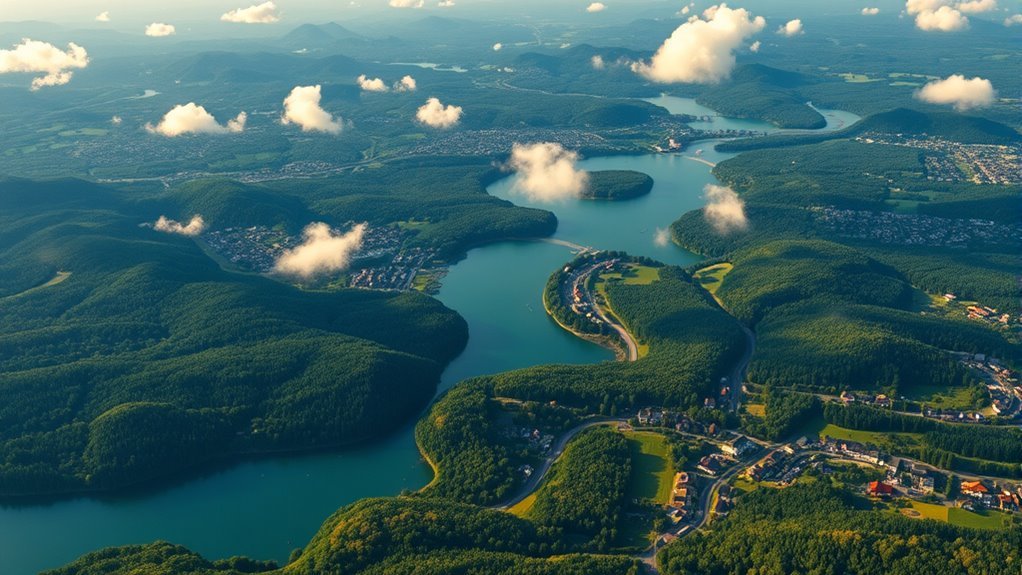If you want the best drone camera, focus on advanced stabilization like gimbals and large sensors for sharp, vivid images, even in low light. Reliable GPS and obstacle avoidance improve flight safety, while 20-30 minute battery life suits most needs. Choose drones with intuitive controls if you’re new, or customizable ones if you’re a pro. Durable materials like carbon fiber boost longevity. Understanding these factors helps, and exploring models deeper reveals which fit your specific filming goals.
Top Features to Consider When Choosing a Drone Camera

When selecting a drone camera, you’ll want to focus on several technical features that directly impact image quality and flight performance. First, consider camera stabilization systems, like gimbals, which guarantee smooth footage despite drone movement or wind interference. This is vital for capturing clear, professional-grade images and videos. Next, pay attention to sensor size and resolution, as larger sensors typically deliver better low-light performance and dynamic range. Understanding drone regulations is equally important; some regions restrict drone weight or camera capabilities, influencing your choice. Battery life and flight range also affect how freely you can explore and capture expansive scenes. Prioritize drones with reliable GPS and obstacle avoidance for safer flights. By balancing these factors, you’ll select a drone camera that offers both creative freedom and compliance with local laws.
Comparison of Image Quality Across Popular Models

Evaluating the image quality of five leading drone cameras reveals distinct strengths and trade-offs that can guide your choice based on shooting needs. Models with advanced image stabilization systems deliver smoother footage, particularly noticeable during fast movements or windy conditions, reducing motion blur effectively. When it comes to low light performance, sensors with larger apertures and higher ISO capabilities maintain detail and minimize noise, allowing you to capture clear images in dim environments. Color accuracy and dynamic range also vary; some drones excel at rendering vivid colors without oversaturation, while others preserve shadow and highlight details better. Ultimately, your decision should balance stabilization quality and low light capabilities against your preferred shooting scenarios to guarantee you get the most freedom and creative control in your aerial photography.
Flight Time and Battery Performance Analysis

Image quality is just one aspect to contemplate; flight time and battery performance play a significant role in how effectively you can capture those images. When evaluating drones, consider battery longevity—how many minutes of continuous flight you get per charge. Most consumer drones offer between 20 to 30 minutes, though some high-end models can push beyond 40 minutes. Charging time is equally critical; shorter charging times mean less downtime and more freedom to operate. You’ll also want to assess whether the drone supports quick-swap batteries, enabling extended sessions without waiting for recharge. Battery efficiency impacts not only flight duration but also payload capacity and stability, affecting your image capture quality. Balancing these factors guarantees you’re equipped for uninterrupted, high-quality aerial photography.
Ease of Use for Beginners and Professionals
Although advanced features can enhance drone capabilities, ease of use remains a vital consideration for both beginners and professionals. When selecting a drone, you’ll want intuitive controls and clear interfaces that support quick learning—beginner tips like automated takeoff, landing, and obstacle avoidance help you fly confidently without extensive experience. For professionals, customizable controls and access to manual settings provide precise adjustments during complex shoots. Look for drones offering seamless app integration, real-time telemetry, and programmable flight paths, enabling you to balance freedom with control. Ultimately, the best drone camera blends user-friendly operation with robust professional features, allowing you to focus on creativity and exploration rather than technical hurdles, regardless of your skill level.
Durability and Build Quality of Leading Drones
Three critical factors determine a drone’s durability and build quality: frame material, component design, and weather resistance. When you choose a drone, the build material greatly impacts impact resistance and longevity. Carbon fiber frames offer lightweight strength, while high-grade plastics provide flexibility and shock absorption. Component design focuses on securing internal parts against vibrations and collisions. Weather resistance, including water and dust sealing, guarantees operational reliability in diverse environments, freeing you to explore without worry.
| Build Material | Impact Resistance |
|---|---|
| Carbon Fiber | High – resists fractures |
| Reinforced Plastic | Moderate – absorbs shocks |
| Aluminum Alloy | High – durable but heavier |
| Magnesium Alloy | Balanced – strong and light |
Understanding these elements helps you select drones that match your adventurous spirit and durability needs.
Advanced Camera Capabilities and Accessories
Beyond the physical durability of a drone, the quality of its camera system defines much of its value, especially if you’re aiming for professional-grade aerial photography or videography. Advanced camera capabilities often include high-resolution sensors paired with versatile zoom capabilities, enabling you to capture detailed images from varying distances without sacrificing clarity. Additionally, lens options matter greatly; interchangeable lenses or integrated wide-angle and telephoto lenses expand your creative control over framing and perspective. Accessory compatibility, such as gimbals for stabilization and filters for light enhancement, further refines image quality and shooting flexibility. When selecting a drone, consider these technical features carefully, as they empower you to explore aerial freedom while achieving precise, high-quality visual results tailored to your specific shooting needs.
Price Range and Value for Money Assessment
When evaluating drones, understanding the price range relative to their features and performance is essential to determining value for money. Prices can vary widely—from entry-level models under $300 to professional-grade drones exceeding $2,000. You’ll want to take budget considerations carefully, balancing essential capabilities like flight time, camera resolution, and stabilization against cost. Value comparisons across models reveal that mid-tier drones often offer the best compromise, delivering advanced sensors and intelligent flight modes without the premium price. Keep in mind, accessories such as extra batteries or enhanced controllers may affect overall expenses. By analyzing technical specifications alongside pricing, you can identify drones that provide ideal performance without overspending, ensuring your investment supports your desire for aerial freedom efficiently and effectively.
Best Drones for Aerial Photography and Videography
Selecting the best drones for aerial photography and videography involves evaluating key technical factors like camera resolution, gimbal stabilization, flight time, and intelligent flight modes. You’ll want a model that balances image quality with maneuverability, while respecting drone regulations to guarantee safe, legal flights. Consider how advanced aerial techniques integrate with your drone’s capabilities for creative freedom.
Look for these features:
- High-resolution camera sensor (20MP+)
- 3-axis gimbal for stable footage
- Minimum 25 minutes of flight time
- Obstacle avoidance and GPS positioning
- Intelligent flight modes (e.g., ActiveTrack, Waypoints)
These elements empower you to capture smooth, professional-grade shots and explore diverse shooting angles without compromising compliance or control.
Software and App Integration for Enhanced Control
Although hardware specifications are essential, the software and app integration plays a crucial role in maximizing your drone’s capabilities and user experience. You’ll want to guarantee software compatibility with your mobile device’s operating system for seamless connectivity. Advanced app features such as real-time telemetry, waypoint navigation, and intelligent flight modes empower you to capture complex shots effortlessly. Intuitive user interfaces reduce learning curves, enabling you to focus on creativity rather than controls. Additionally, firmware updates delivered through apps enhance performance and introduce new functionalities, extending your drone’s versatility. When evaluating drones, consider how well the app integrates with your workflow and the reliability of its connection protocols. This integration ultimately grants you freedom to control your drone precisely while revealing its full potential in diverse flying conditions.
Maintenance Tips to Extend Your Drone’s Lifespan
Proper maintenance is essential for ensuring your drone remains reliable and performs at its best over time. To extend your drone’s lifespan, focus on critical areas like drone storage and battery care, which prevent premature wear and capacity loss. Regular firmware updates optimize flight stability and security. Propeller maintenance and sensor cleaning are crucial for safe, accurate operation. Don’t overlook weather protection to shield components from moisture and dust, plus routine motor inspection and landing gear checks to catch mechanical issues early.
- Store drones in a cool, dry place to avoid damage
- Charge and discharge batteries properly to maximize life
- Keep firmware updated for improved functionality
- Inspect and replace damaged propellers promptly
- Clean sensors gently to maintain flight accuracy
Consistent care lets you fly freely, worry-free.

